TOWS Analysis is a strategic planning method that helps organizations identify their internal strengths and weaknesses and external opportunities and threats. The acronym TOWS stands for Threats, Opportunities, Weaknesses, and Strengths.
It helps organizations identify opportunities and threats they should address to achieve their goals. This method provides a framework for analyzing an organization’s current situation and helps it to develop a strategic plan to achieve its goals.
This article will provide a comprehensive overview of this model, including its definition, purpose, importance, and critical components. It also explores the difference between this tool and SWOT Analysis and provides an overview of the steps involved in conducting a TOWS Analysis.
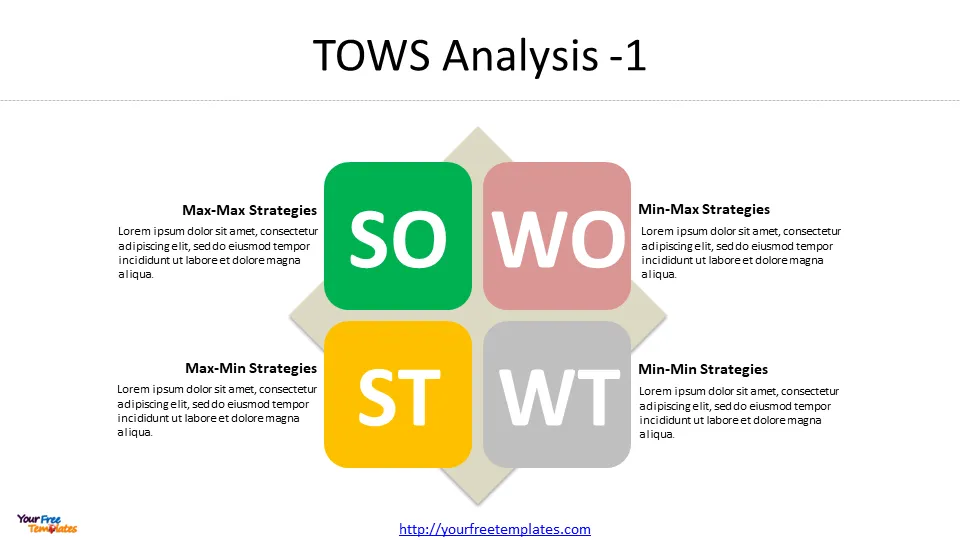
There are 9 professional TOWS Analysis Templates designed by our team together with What is the TOWS Analysis and how can it help?
- Explanation of the Concept of TOWS Analysis
- How TOWS Analysis Differs from SWOT Analysis
- Steps involved in TOWS Analysis
- Benefits of TOWS Analysis
- Final Words
As the same diagram PowerPoint template series, you can also find our Data Mining, marketing segment, Porter’s five forces, SWOT Analysis, GE Matrix, BCG Matrix, Artificial Intelligence, National Diamond and BlockChain PowerPoint templates.

Explanation of the Concept of TOWS Analysis
It is a strategic planning method that helps organizations identify their internal strengths and weaknesses and external opportunities and threats. This method provides a framework for analyzing an organization’s current situation and helps it to develop a strategic plan to achieve its goals.
The critical components of this model are identifying an organization’s strengths, weaknesses, opportunities, and threats. Strengths are internal factors that give the organization an advantage over its competitors. Weaknesses are internal factors that limit the organization’s ability to achieve its goals. Opportunities are external factors that the organization can leverage to achieve its goals. Threats are external factors that may limit the organization’s ability to achieve its goals.
There are several reasons why this model is essential.
- First, it helps organizations identify their strengths and weaknesses, which is essential for improving performance.
- Second, it helps organizations identify external opportunities and threats, which is essential for adapting to environmental changes.
- Third, it helps organizations evaluate different options and choose the best strategy, which is essential for success.
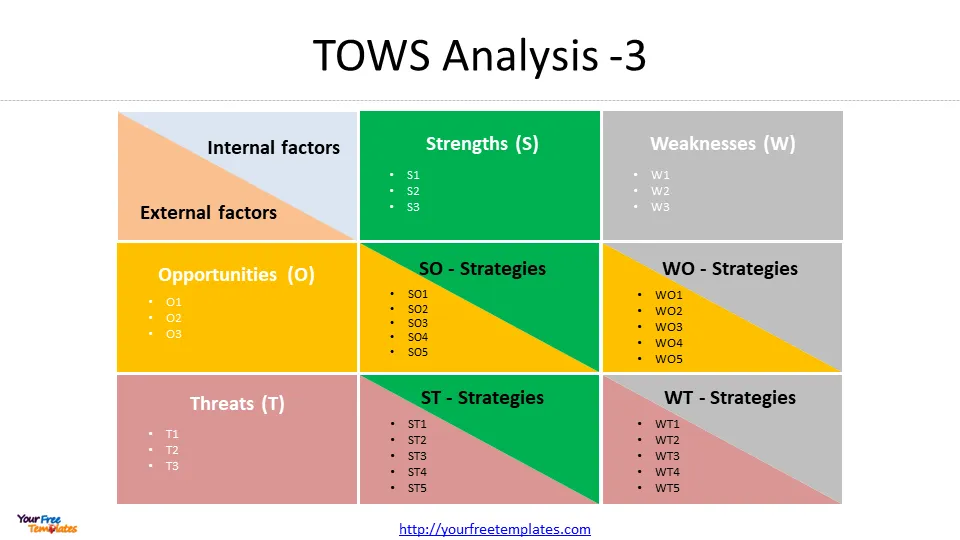
How TOWS Analysis Differs from SWOT Analysis
TOWS Analysis and SWOT Analysis are strategic planning tools that help organizations identify their internal strengths and weaknesses and external opportunities and threats. However, there are several critical differences between TOWS Analysis and SWOT Analysis.
- One of the main differences between this tool and SWOT Analysis is that TOWS Analysis is more action-oriented. While SWOT Analysis identifies an organization’s strengths, weaknesses, opportunities, and threats, TOWS Analysis evaluates different options and chooses the best strategy. That makes TOWS model more practical and valuable for organizations looking to implement specific changes.
- Another difference between TOWS Analysis and SWOT tool is that TOWS Analysis provides a more comprehensive framework for analyzing an organization’s current situation. While SWOT Analysis focuses solely on identifying an organization’s strengths, weaknesses, opportunities, and threats, TOWS Analysis includes evaluating different options and developing a specific plan to achieve the organization’s goals.
- Additionally, TOWS Analysis is more structured than SWOT Analysis. TOWS Analysis requires organizations to consider all possible strategies for addressing their strengths, weaknesses, opportunities, and threats. That allows organizations to make more informed decisions and develop a comprehensive plan for achieving their goals.
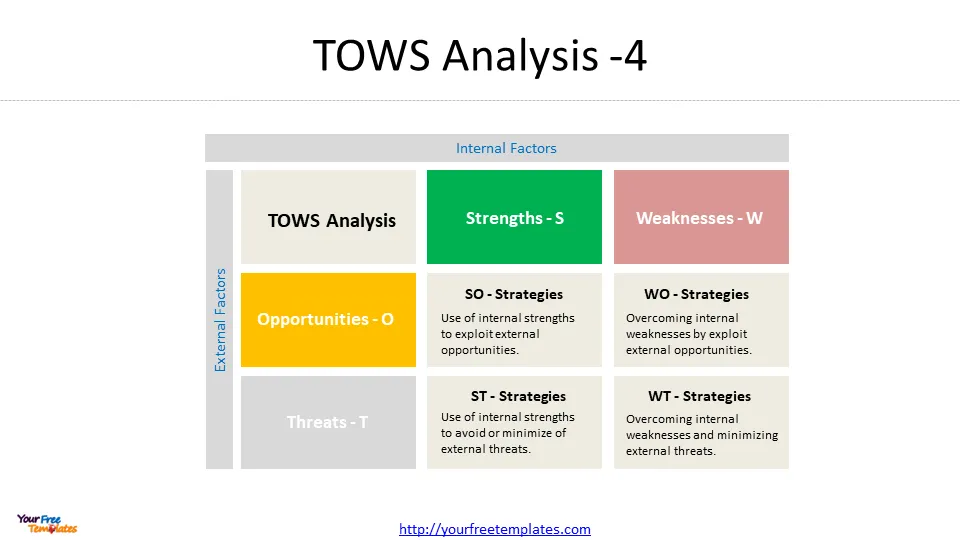
Steps involved in SWOT Analysis
The TOWS Analysis process consists of four steps that help organizations identify their internal strengths and weaknesses, external opportunities and threats, and develop a strategic plan to achieve their goals.
Step 1: Identify the organization’s internal strengths and weaknesses
The first step in the TOWS Analysis process is to identify the organization’s internal strengths and weaknesses. Strengths are internal factors that give the organization an advantage over its competitors, such as a strong brand, talented employees, or efficient processes. Weaknesses are internal factors that limit the organization’s ability to achieve its goals, such as outdated technology, insufficient resources, or poor management practices.
Step 2: Identify the external opportunities and threats
The second step in the TOWS Analysis process is to identify the external opportunities and threats facing the organization. Opportunities are external factors that the organization can leverage to achieve its goals, such as new market opportunities, advances in technology, or changes in regulations. Threats are external factors that may limit the organization’s ability to achieve its goals, such as increased competition, economic downturns, or natural disasters.
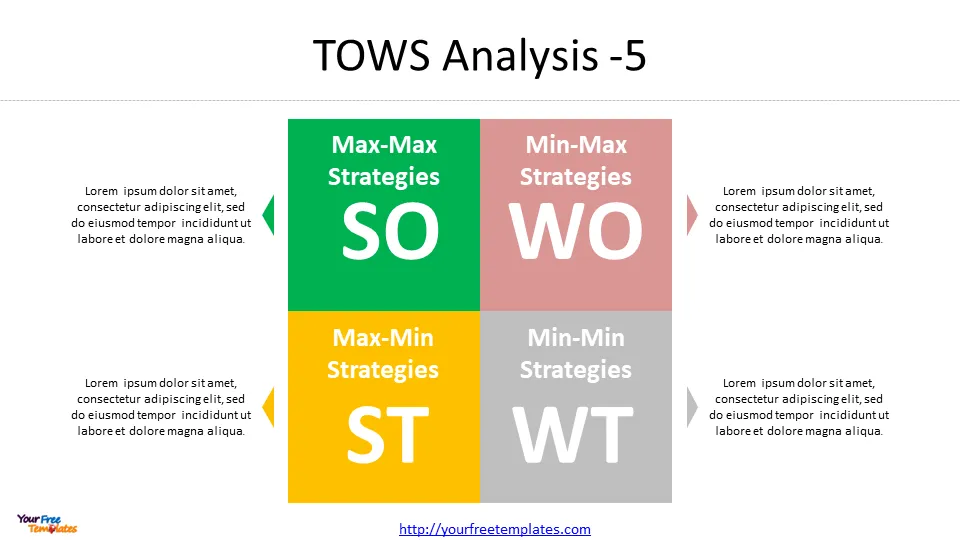
Step 3: Develop with the TOWS matrix
The third step in the TOWS Analysis process is to develop the TOWS matrix. It is a visual representation of the information gathered in the first two steps, and it helps organizations to evaluate different options and choose the best strategy. The TOWS matrix consists of four quadrants: SO (Strengths-Opportunities), ST (Strengths-Threats), WO (Weaknesses-Opportunities), and WT (Weaknesses-Threats).
Step 4: Evaluate the options and choose the best strategy
The final step in the TOWS Analysis process is to evaluate the options and choose the best strategy. Organizations can use the information gathered in the TOWS matrix to evaluate different options and choose the best strategy to achieve their goals. That may involve developing new products, entering new markets, improving processes, or seeking new partnerships. The goal is to choose a strategy that leverages the organization’s strengths, addresses weaknesses, capitalizes on opportunities, and protects against threats.

Benefits of TOWS Model
TOWS Analysis is a valuable tool for organizations looking to improve their performance and achieve their goals. The benefits of TOWS Analysis include the following:
- Helps organizations identify their strengths and weaknesses
It helps organizations identify their internal strengths and weaknesses. It allows organizations to understand their current situation better and make informed decisions about improving their performance. Organizations can leverage their strengths to achieve their goals by identifying their strengths. Organizations can develop a plan to address these limitations and improve their overall performance by identifying their weaknesses.
- Facilitates the identification of external opportunities and threats
It also facilitates identifying external opportunities and threats facing the organization. It allows organizations to understand their environment and make informed decisions about capitalizing on opportunities and protecting against threats. By identifying these external factors, organizations can develop a strategy to achieve their goals and stay ahead of the competition.
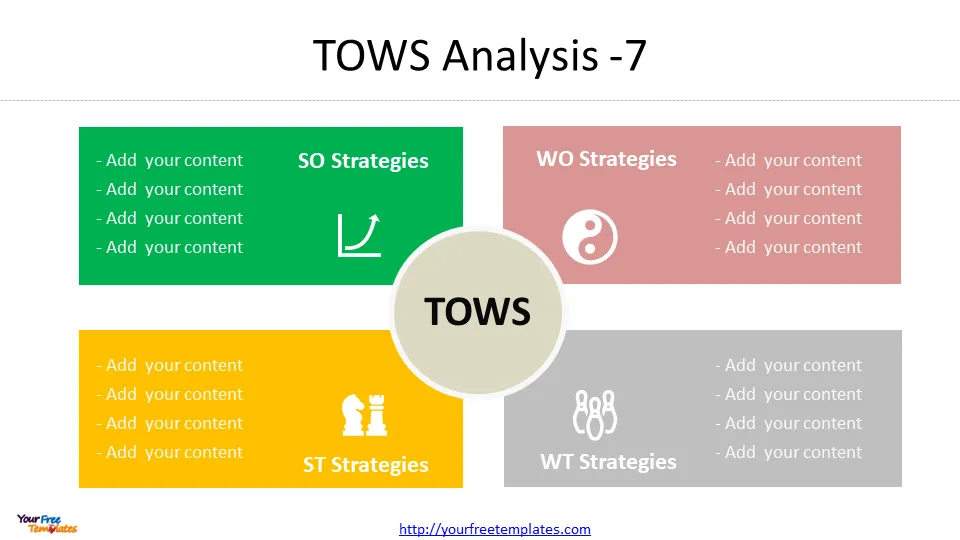
- Enhances decision-making by evaluating different options
TOWS Analysis enhances decision-making by evaluating different options and choosing the best strategy. It allows organizations to make informed decisions and develop a comprehensive plan to achieve their goals. By evaluating different options, organizations can choose the best strategy to leverage their strengths, address their weaknesses, capitalize on opportunities, and protect against threats.
- Improves overall strategic planning
Finally, TOWS Analysis enhances decision-making by providing a structured framework for evaluating different options and choosing the best strategy. That allows organizations to make informed decisions.

Final Words
TOWS Analysis is more relevant than ever in today’s fast-paced and highly competitive business environment. It provides organizations with a comprehensive understanding of their external and internal factors, which can help inform critical decision-making and improve overall performance.
TOWS Analysis should be integrated into the strategic planning process regularly. That will allow the organization to make informed decisions. Additionally, TOWS Analysis should be performed periodically and updated to reflect changes in the internal and external environment.
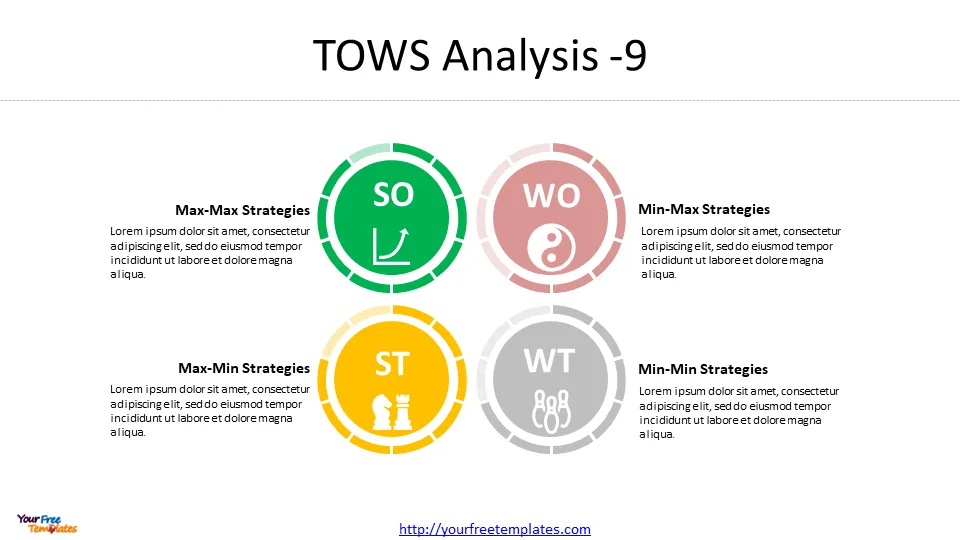
For other interesting maps, pls visit our ofomaps.com
Size:206K
Type: PPTX
Aspect Ratio: Standard 4:3
Click the blue button to download it.
Download the 4:3 Template
Aspect Ratio: Widescreen 16:9
Click the green button to download it.
Download the 16:9 Template














